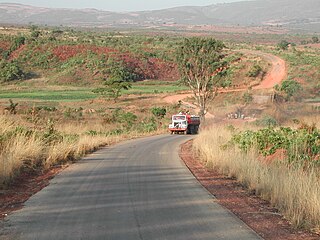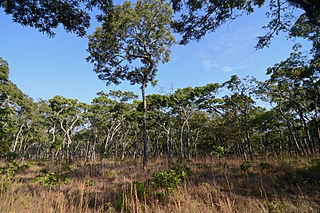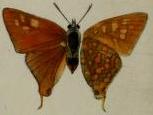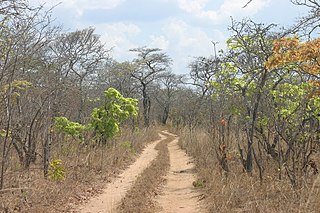
Zambia is a landlocked country located in Southern Africa, to the east of Angola. It has a total area of 752,618 square kilometres, of which 9 220 km2 is water.

Brachystegia spiciformis, commonly known as zebrawood, or msasa, is a medium-sized African tree having compound leaves and racemes of small fragrant green flowers. The tree is broad and has a distinctive amber and wine red colour when the young leaves sprout during spring (August–September). It grows in savanna, both open woodland and closed woodland of Southern and Eastern Africa, mostly Tanzania, Zambia, Zimbabwe, Malawi and Mozambique. The word msasa is commonly used as a proper name in African place names. The word also means 'rough plant' in Swahili. Other common names: mundu, myombo, mtondo (Tanzania), muputu (Zambia). The plant is known in the Venda language as mutsiwa, which means 'the one that is left behind'. An outlying population of Brachystegia has recently been discovered in the Soutpansberg mountains of northern South Africa. This tree is a protected species in South Africa.

Brachystegia is a genus of tree of the subfamily Detarioideae that is native to tropical Africa.

The Eastern miombo woodlands (AT0706) are an ecoregion of grassland and woodland in northern Mozambique, southern Tanzania, and southeastern Malawi.

The short-winged cisticola, also known as the siffling cisticola, is a species of bird in the family Cisticolidae. It is found in Angola, Benin, Burkina Faso, Burundi, Cameroon, Central African Republic, Chad, Republic of the Congo, Democratic Republic of the Congo, Ivory Coast, Eritrea, Ethiopia, Gabon, Gambia, Ghana, Guinea, Guinea-Bissau, Kenya, Liberia, Malawi, Mali, Mozambique, Niger, Nigeria, Rwanda, Senegal, Sierra Leone, Somalia, South Sudan, Tanzania, Togo, Uganda, Zambia, and Zimbabwe.

The rattling cisticola is a species of bird in the family Cisticolidae which is native to Africa south of the equator, and parts of East Africa. It is a common to abundant species in open savanna and scrubland habitats, whether in arid, moist or upland regions. Especially during summer, it is highly conspicuous due to its strident and repetitive call-notes from prominent perches.

Julbernardia globiflora is a tropical African tree widespread at moderate altitudes in Miombo woodland to the south and east of the equatorial forest region of the Congo basin. Its common name is mnondo. It is ecologically important over wide areas and is dominant to co-dominant in many types of woodland, always being most successful in drier types of deciduous woodland where there is less competition.
Julbernardia paniculata is a medium to large tropical tree, also known as muchesa. It is widespread over the warmer parts of south tropical Africa, preferring moderately high altitudes, typically 1,000 to 1,200 metres. It is very common over its range and is the dominant woodland tree in Miombo woodland over much of central Zambia and northern Malawi.

Angolan miombo woodlands cover most of central Angola and extend into the Democratic Republic of Congo. They are part of the larger miombo ecosystem that covers much of eastern and southern Africa.

The Central Zambezian miombo woodlands ecoregion spans southern central Africa. Miombo woodland is the predominant plant community. It is one of the largest ecoregions on the continent, and home to a great variety of wildlife, including many large mammals.

The Southern Zanzibar–Inhambane coastal forest mosaic, also known as the Southern Swahili coastal forests and woodlands, is a tropical moist broadleaf forest ecoregion of eastern Africa. It is a southern variation of Northern Zanzibar-Inhambane coastal forest mosaic. The ecoregion supports habitats of forest, savanna and swamps. The southern portion of the ecoregion is not as well studied due to the 1977-1992 civil war in Mozambique.

Bicyclus angulosa, the startled bush brown, is a butterfly in the family Nymphalidae. It is found from Senegal to Cameroon, in the Central African Republic, the Democratic Republic of the Congo, Sudan, Uganda, Ethiopia, Kenya, Angola, Tanzania, Zambia, Malawi, Mozambique and Zimbabwe. The habitat consists of dense savanna, including Brachystegia woodland.

Aphnaeus erikssoni, the Eriksson's highflier, is a butterfly in the family Lycaenidae. It is found in Angola, Namibia, Zambia, the Democratic Republic of the Congo, Tanzania, Malawi, Mozambique and Zimbabwe. The habitat consists of savanna and open woodland.
Aslauga marshalli, the dusky purple, is a butterfly in the family Lycaenidae. It is found in Cameroon, Angola, the Democratic Republic of the Congo, Burundi, Uganda, Kenya, Tanzania, Malawi, Zambia, Mozambique, Zimbabwe and possibly Nigeria. The habitat consists of savanna, Brachystegia-Julbernardia woodland, marshes and shallow lakes.

Northern Zanzibar–Inhambane coastal forest mosaic, also known as the Northern Swahili coastal forests and woodlands, is a tropical moist broadleaf forest ecoregion of coastal East Africa. The ecoregion includes a variety of habitats, including forest, savanna and swamps.

The Zambezian and mopane woodlands is a tropical and subtropical grasslands, savannas, and shrublands ecoregion of southeastern Africa.

Calleagris jamesoni, Jameson's flat or Jameson's skipper, is a butterfly in the family Hesperiidae. It is found in Angola, the Democratic Republic of the Congo, Tanzania, Zambia, Malawi, Mozambique, Zimbabwe and Botswana. Their habitat consists of Brachystegia woodland, savanna and forest margins.
The Mueda Plateau, also known as the Maconde Plateau, is a plateau in Cabo Delgado Province of northeastern Mozambique.

The Southern miombo woodlands is a tropical grasslands and woodlands ecoregion extending across portions of Malawi, Mozambique, Zambia, and Zimbabwe.
The Zambezian region is a large biogeographical region in Africa. The Zambezian region includes woodlands, savannas, grasslands, and thickets, extending from east to west in a broad belt across the continent. The Zambezian region lies south of the rainforests of the Guineo-Congolian region. The Zambezian region is bounded by deserts and xeric shrublands on the southwest, the Highveld grasslands of South Africa to the south, and the subtropical Maputaland forests on the southeast.














